Gas cylinders made of composite materials: pros and cons of Euro gas cylinders
If you need a container for storing liquefied gas, you should definitely consider an option such as a composite gas cylinder.This is a modern development that allows you to store the combustible mixture in the safest way. In addition, such cylinders are very convenient to use.
We invite you to read the article, which discusses in detail the design differences of the device and the principle of operation. To make an informed purchase, we list the positive and negative aspects of the polymer Euro-tank for gas. Safe operation will be ensured by compliance with the rules we set out.
The content of the article:
Operating principle and device
For the manufacture of Eurocylinders, fiberglass and epoxy resin are used. To make a flask, a thread made of high-quality fiberglass is wound around a special mold. Then this dense winding is thoroughly impregnated with epoxy resin. The composition is treated with a hardener.
After the flask has completely hardened and acquired the necessary strength, further work can be continued. Valves, valves and other devices that regulate the operation of the container are inserted into the prepared connectors.
A removable plastic casing is placed on top, equipped with handles for carrying the cylinder. This lattice shell can be removed or replaced if necessary.

The polypropylene from which such containers are made is completely environmentally friendly.Such material is not difficult to dispose of and does not require expensive special procedures. If desired, the material can be given almost any color.
Some companies order a batch of containers with a unique design for the sake of corporate style or for practical needs, for example, to distinguish between cylinders with different contents or intended for different departments, etc. High environmental safety requirements are one of the main conditions for the production of composite gas cylinders.

For example, only glass fiber is used, in the manufacture of which no dangerous substance such as boron was used, which improves the characteristics of the material without high costs. To produce composite flasks, glass fiber is used, which is made with a safer boron substitute.
The resulting composite material does not tarnish or fade and maintains uniform transparency because it remains resistant to ultraviolet radiation for a long time. A slight change in color of a bulb made of composites can occur only a few years after the start of use.
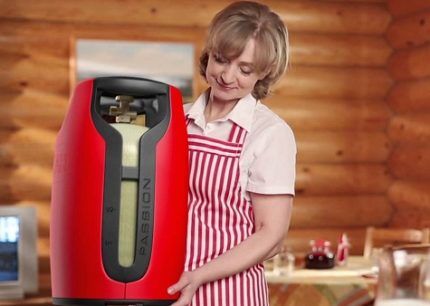
But even in this case, the remaining functional characteristics of the cylinders will not change.The outlet of gas cylinders, which are made of composite materials, is usually standardized according to the types EN 11363, EN 629 or DIN 477. The 25E inlet valve allows you to easily fill the container with accessible means.
Euro cylinders resist rupture much better than metal containers under similar conditions. To explode a composite cylinder, you will need to create a force inside it that is approximately twice as high as that at which conventional gas cylinders explode.
Although, in accordance with GOST requirements, any gas cylinder must withstand a pressure of at least 50 atm exerted on the device body, which is enough to ensure the required level of safety.
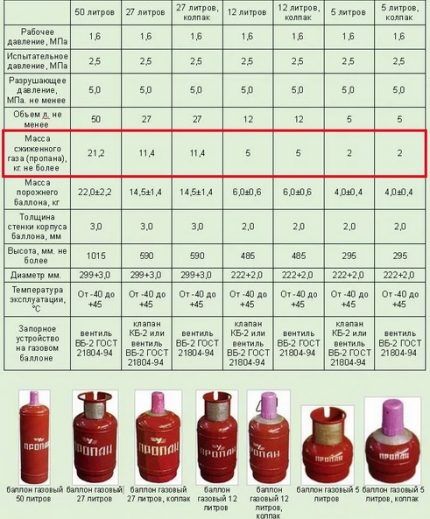
Metal cylinders are equipped with valves of the VB-2 type, and to increase the level of safety it is necessary to additionally install safety devices. Compare the composite option with others types of gas cylinders you can by reading our recommended article.
Most often this is a special gearbox with a valve; such products manufactured under the GOK brand are popular. On composite cylinders, all the necessary fuses are already installed; there is no need for additional protective equipment.
Depending on where the composite cylinder is manufactured, it may vary slightly. For example, Norwegian-made Eurocylinders, such as Ragasco LPG 24.5, are not as transparent as devices from other companies.To determine the amount of liquefied gas in them, you need to pump the cylinder a little.
Laboratory tests show that Eurocylinders demonstrate high resistance to statistical fatigue at a temperature of 70 degrees. As for the heat transfer capabilities of composite structures, at temperatures down to -15 degrees they show the same characteristics as their metal counterparts.
The evaporation rate is usually about 300 g/h. However, if you intend to use a device of this type at lower temperatures, or when a different LPG evaporation rate is needed, you should carefully study the characteristics of the selected model.
The outside temperature can significantly affect the rate of evaporation of liquefied gas, which can affect the efficiency of the device. In such situations, it is recommended to take care of additional insulation of the container.
Advantages and disadvantages of European containers
Cylinders made of polymer materials are very convenient to store. Such containers can be stored on top of each other, for example, in stacks.
They can be connected to the same types of gas appliances that are designed for standard gas supply devices. Liquefied gas can be transported in such containers; they can be used at home and during outings, for long-term storage of LPG, etc.
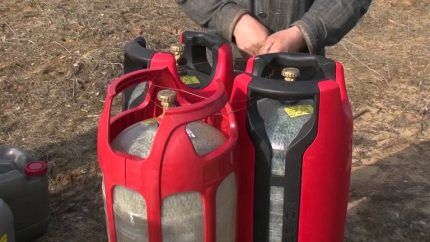
The weight of composite devices is about a third less than their metal counterparts, but in terms of strength they are in no way inferior to them.Another advantage of devices of this type is the wide range. They vary widely in volume and shape. You can always choose the option that suits a particular case.
The walls of such containers have some transparency, which allows you to visually assess the amount of liquefied gas remaining inside. Over time, the transparency of the cylinder is not lost, and the amount of gas inside does not affect it. Composite materials do not spark upon impact, so the risk of an accidental explosion is virtually eliminated.
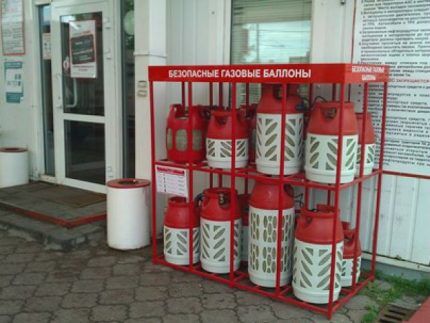
Of course, the development of corrosion processes also does not threaten products made from polymers. The material can withstand heating up to temperatures of 100 degrees. These cylinders look very attractive and modern, you can choose the appropriate color. A cylinder with a capacity of about 20 kg weighs approximately seven kilograms or less.
In terms of weight, composite containers with a plastic protective casing are almost two times lighter than metal cylinders of the same volume. Buyers note that the handles on the composite cylinder make it even more convenient to use. The light weight and handles allow even a fragile woman to handle loading a medium-sized container.
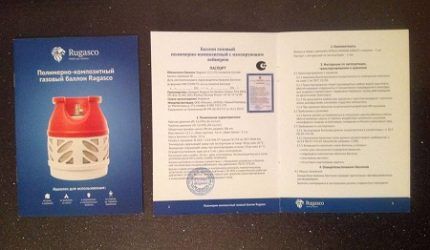
Typically, the manufacturer's warranty on composite LPG cylinders is two years. But the service life is 30 years, and with careful handling even more.The bulb of the composite cylinder is protected on top by a special plastic casing, which increases the strength of the device.
In the event of an accidental fall, the force is applied to this casing; even if it cracks, the flask and its dangerous contents will remain safe and sound. A damaged casing can be replaced with a new one. This operation is much cheaper than completely replacing the cylinder.
Static electricity is also not a threat to such a device. This point has been confirmed in numerous practical studies. The appearance of random sparks, fire and explosion are excluded for this reason.
It is recommended that composite cylinders be inspected once every decade, while similar inspections of metal gas storage products should be performed twice as often, i.e. every five years.

One of the significant disadvantages of Eurocylinders is the price. The cost of composite containers is approximately four times higher than the cost of metal counterparts. Still, it makes sense to invest in such a container, since it is lighter, more convenient and safer than a regular metal cylinder. The high price of Euro cylinders is quite understandable.
Their production technology requires high costs. Such containers are produced abroad, so the price also includes delivery costs, customs duties, etc.
The additional costs are unlikely to be recouped if you replace not one, but several metal gas cylinders with a composite container. The main benefit in this case is more convenient use and an increased level of security.
Useful information about safe use
Of course, a mandatory element of any composite gas cylinder is safety devices. Composite models are no exception. It is mandatory to install on each device pressure reducer. If it exceeds the minimum permissible threshold, the valve will open and part of the gas will be released, which will avoid rupture of the structure.
At the same time, the gas cylinder continues to operate normally. Another protective element that is installed on Eurocylinders is a fusible insert. At dangerous levels of heating, it melts, preventing the structure from overheating. Previously, spring fuses were used for these purposes, but the new element is considered more reliable.
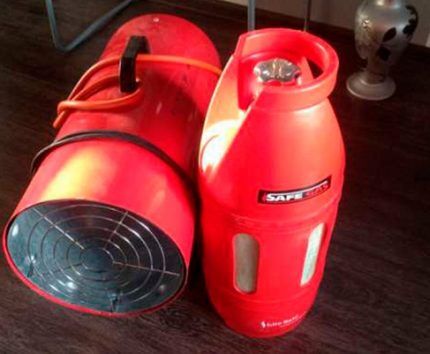
After the insert melts, for example due to overheating during a fire, the gas exits the container in a safe, controlled manner. Unfortunately, after this it is impossible to restore the fuse link; the cylinder becomes unsuitable for further use.
Of course, you should not heat Eurocylinders to such high temperatures unless absolutely necessary. The operating range for such structures is considered to be from 40 degrees below zero to 60 degrees above zero.
Can a composite cylinder explode? From a spark - no, but if the pressure inside the container accidentally increases, then the likelihood of such an outcome will increase significantly. Therefore, statements about the absolute explosion safety of cylinders do not correspond to reality.
The reason for the increase in internal pressure inside such a cylinder may be heating of the body, causing the liquefied gas to evaporate too quickly.
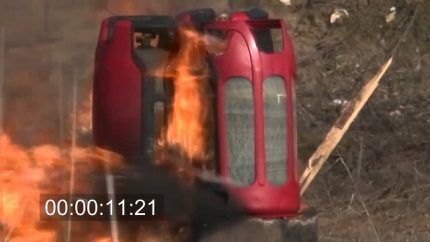
And yet, the explosion of a Euro cylinder is an extremely rare occurrence. When exposed to open fire, the fuse link will trip and part of the housing may also melt. The gas will leave the container through these holes without it exploding. The use of flammable gas is always carried out in compliance with increased safety precautions.
Although the composite cylinder itself cannot explode, a gas leak through a large hole can cause an explosion. Therefore, regular checking of the integrity of the container must be carried out without fail. Proper maintenance of composite gas cylinders will extend their service life.
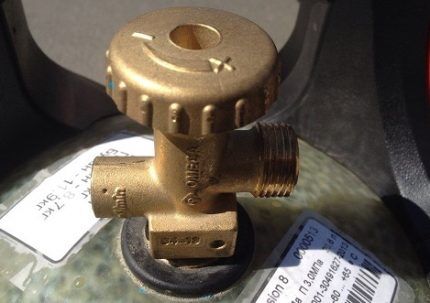
Each new product contains a notice on the body reminding you to fully inspect and possibly replace the product every ten years.
Of course, standard inspection and examination of the cylinder should be performed much more often:
- before filling it with liquefied gas;
- during such refueling;
- after the container is filled with LPG.
The cylinder check includes the following requirements:
- the brand of fuel and the type of cylinder must match each other;
- maintenance of the tank should be carried out within the established time limits;
- it is necessary to verify the integrity of both the composite flask itself and the markings applied to it.
If the test results are unsatisfactory in one of the mentioned points, the container should be sent for an extraordinary technical inspection to ensure its suitability for further use. In this case, the wear of the cylinder is analyzed. The presence of scratches, abrasions, dents and other damage on the body is taken into account.
The condition of each damage is analyzed to determine whether it poses a threat to the overall integrity of the container. The condition of such deficiencies should be monitored from the moment they appear. When checking the labeling of a gas cylinder made of composite materials, you need to ensure its integrity.

It would be a gross and dangerous mistake to fill such a cylinder with fuel for which it is not intended. Different manufacturers label differently. This can be a barcode or a special sticker that is laminated and securely attached to the case.
Data such as the barcode and serial number of the product must be specified and saved. If this information is lost in whole or in part, the cylinder may have to be discarded and replaced with a new product.
Another important point is checking the integrity of the valve. This element must be screwed into the hole intended for it. The area of its contact with the flask material is strictly standardized.
Modern composite cylinders are equipped with shut-off valves that meet international standards.In addition, you need to monitor the serviceability of shut-off and control devices both on the device itself and on the one used for the connected line. Installation and replacement of gas taps and hoses must be manufactured in accordance with regulations.
For safety reasons, when refilling cylinders and replacing a gas tap, it is better to choose enterprises that can provide licenses and permits for this type of activity.
Conclusions and useful video on the topic
Information on the production of containers of this type can be found here:
Gas cylinders made of composite materials are relatively new designs, but they have already confidently supplanted their metal “brothers”. Such products are much more convenient and safe to use. With proper use and maintenance, they will serve flawlessly for many years.
Have you ever used a composite gas cylinder? Maybe you know the technical nuances of its operation and connection that are not described in the article? Please write comments, ask questions, share your impressions, useful information, and post photos on the topic in the block below.




I am engaged in the production and assembly of cabinet furniture, the workshop is not heated, so I selected options for heat generation. Operating an electric gun is expensive, ordinary gas cylinders are heavy and quite explosive, now I have made my choice. In my opinion, the best option is a cylinder made of composite materials: it is safer, especially taking into account the specifics of my work.
The price is a huge disadvantage, which kills the demand for composite cylinders. The advantages are insignificant.
Can these cylinders be used in multi-storey buildings?
In a multi-storey building (above 2 floors), according to the law, you cannot use gas cylinders at all - neither composite nor any other. See paragraph 8.2.5 of SNIP 42-01-2002.
Really? How about storing it on the balcony for refilling tourist cylinders for burners?
Please tell me where in St. Petersburg I can find an organization that provides maintenance of composite gas cylinders?
Hello. Try contacting these organizations and clarifying this issue directly - https://clck.ru/GxTtN
Good afternoon. I want to buy a Bolu or Bartolini primovera heater and there is a gas cylinder in the stove itself, but then how can I use it if you write that it cannot be used indoors. And where can I find a composite balloon in the Moscow region in Istra?
In the production of cotton mattresses kpb24.ru we use only such products.